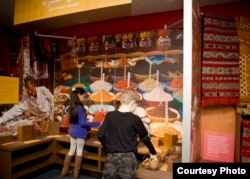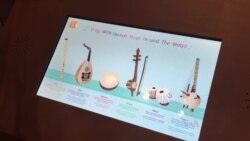Imagine a place where children can steer a dhow boat across the Indian Ocean, sell Egyptian spices and Moroccan rugs, hop on a camel and embark across the Sahara. “America to Zanzibar: Muslim Cultures Near and Far” is a groundbreaking interactive museum exhibit in the heart of New York City that lets kids do just that: explore the A-to-Z of Muslim cultures.
The Children’s Museum of Manhattan (CMOM), established in 1973, is a hands-on cultural destination for families committed to nurturing “the next generation of global citizens.”
CMOM’s executive director, Andrew Ackerman, says the addition of the Muslim cultures exhibit allows families an opportunity to discuss unity and diversity within the same tradition — a factor he says is crucial for developing young minds.
“Those attitudes really form very early in life,” Ackerman said. “So part of our role as a children’s museum is to open their minds and experiences with very positive images about people from different lifestyles and different parts of the world, so that negative stereotypes don’t take root.”
Across from the courtyard, next to a life-size 900-pound camel, is the "American home" living room, made up of clothing, artwork, photos and books donated from American Muslims of all walks of life. On the coffee table, there is an app that teaches you how to write and say “My name is …” in 24 languages spoken by Muslims in New York.
The city’s mayor, Bill de Blasio, has praised the exhibit as an “important cultural resource,” calling New York Muslim residents a “vital part” of the city’s diverse communities.
“Children will have the chance to learn about Muslim cultures in an engaging and thoughtful way,” said de Blasio. “We only grow stronger when we embrace and celebrate the multitude of cultural backgrounds that make up New York City.”
Early childhood development
Independent research from the American Association for the Advancement of Science indicates that children in the U.S. begin to understand the concept of race and ethnicity by the age of four. By the time they turn five, children may have already developed solidified stereotypes about various social groups.
Lizzy Martin, director of exhibit development and museum planning at CMOM, says the exhibit employs a multifaceted approach to engage children, in order to suit their individual learning needs.
“Some people might learn through their senses, and therefore they can smell the spices or smell the fruits," she said. "Some might be more tactile — so the rugs — and some might be more visual, so you might want fabrics. Or some might be more auditory.”
For the kinesthetic learners, the exhibit features a music-making booth using digital versions of popular instruments, such as the oud, ghijak or kora.
WATCH: CMOM's Andrew Ackerman 'plays' instruments in 'Musicians Corner'
Fans of panoramic images (and IMAX theaters) can marvel at the architectural beauty and variation of world mosques beneath a 21-foot curved screen, transporting you at the speed of light from a bird’s-eye view in outer space to a prayer room rug on the ground floor.
‘A place of hope’
Ackerman describes the exhibit, and the museum as a whole, as a microcosm of “the real heart and soul of America”: a place of hope; a safe haven for families.
After the September 11 terrorist attacks in 2001, he felt a brief moment of uncertainty about the museum’s future.
“We didn’t know if people would come,” he said. “And we were so crowded. Parents were saying, ‘We trust you. You’re going to let us be who we are, and we’re going to shut the TV off. We’re going to just be families.’”
“That is something we’ll never forget,” he added. “That’s what we do every day.”












